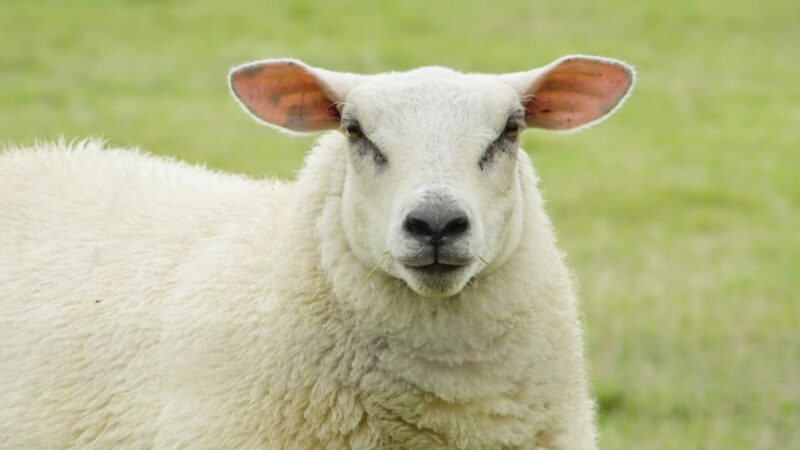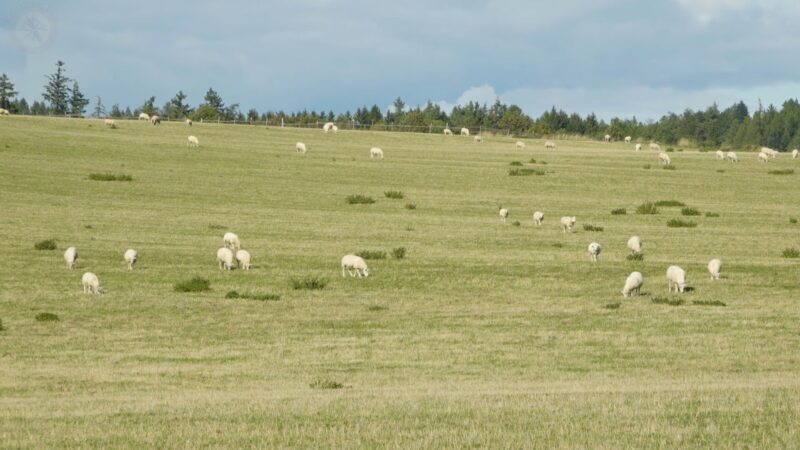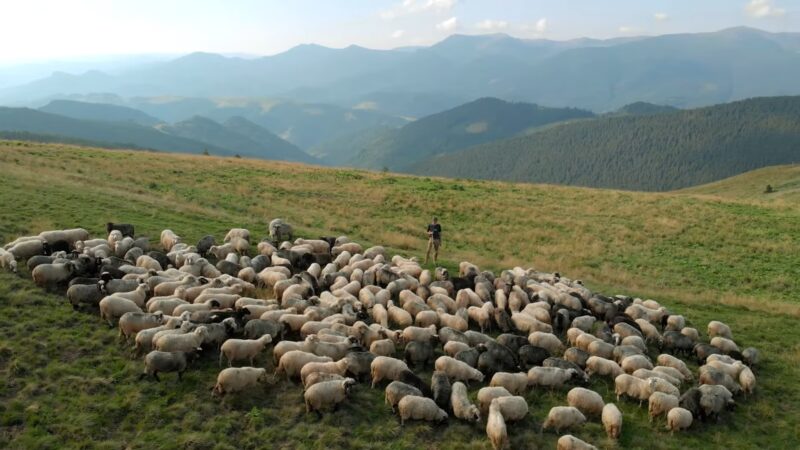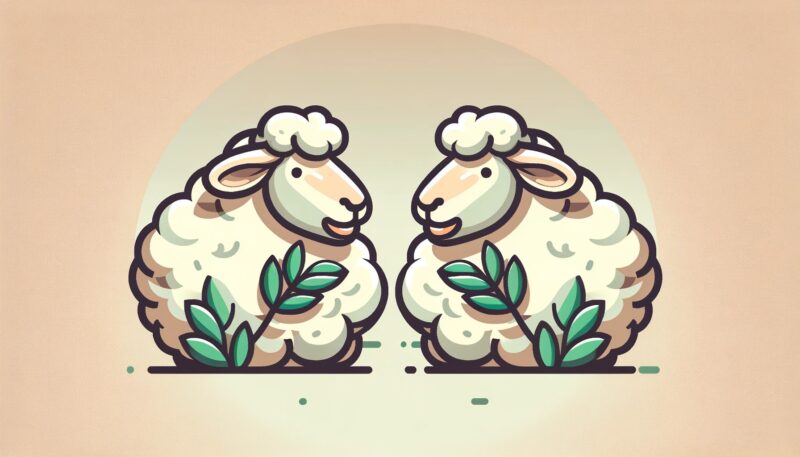Sheep are among the most familiar of domesticated animals, their flocks dotting pastoral landscapes around the world. Known for their woolly coats and the distinctive sound they make, the ‘baa’ of a sheep is as iconic as the animal itself.
But why do sheep baa? This question delves into a fascinating aspect of animal behavior, shedding light on communication, social structures, and even the evolutionary aspects of these gentle creatures.
Sheep vocalizations, commonly referred to as ‘baa’ or ‘bleat’, are the sounds made by sheep as a form of communication. These sounds vary in pitch, length, and intensity, and are used by sheep to express a range of emotions and needs.
The vocal cords located in the sheep’s larynx are responsible for producing these sounds. When air is pushed from the lungs through the larynx, the vocal cords vibrate, creating the familiar baaing sound.
The modulation of this sound is controlled by the sheep, allowing them to communicate different messages.
Communication and Social Interaction

At the heart of the question of why sheep baa is their need for communication. Sheep are highly social animals and their survival depends on their ability to interact with one another.
Vocalizations play a crucial role in this interaction.
- Mother-Offspring Bonding: One of the most critical uses of vocalizations is between a ewe (mother sheep) and her lamb. Immediately after birth, a mother and her lamb will begin to recognize each other’s vocalizations. This is crucial for bonding and helps the lamb to identify its mother among the flock.
- Expressing Emotional States: Sheep use different types of baas to express their emotional states. A high-pitched, prolonged baa may indicate distress or discomfort, whereas a softer, shorter baa might be a sign of contentment. By vocalizing their emotions, sheep can alert their flock mates to potential dangers or changes in their environment.
- Group Cohesion: Sheep are herd animals, and their vocalizations play a role in maintaining group cohesion. When separated from the flock, sheep will baa to signal their location to others. This not only helps lost sheep find their way back but also alerts the rest of the flock to potential danger.
Evolution

The evolution of sheep’s vocalizations is a topic of interest in understanding why they baa. Over thousands of years, domesticated sheep have evolved from wild species that likely had their unique system of vocal communication.
Through the process of domestication and selective breeding, certain traits, including vocalization patterns, were favored. The evolution of sheep vocalizations can be seen as an adaptation to their environment and social structures.
In the wild, being able to communicate effectively would have been crucial for survival, aiding in locating lost members of the flock, alerting to predators, or coordinating movement.
Differences Among Breeds
Not all sheep sound the same. There is a remarkable variation in the baas of different breeds of sheep.
These differences can be attributed to various factors, including the size and shape of the vocal cords, the breed’s specific environment, and selective breeding practices. For example, a Merino sheep might have a different-sounding baa compared to a Suffolk sheep.
This variation adds another layer of complexity to understanding sheep communication, as each breed may have slightly different ways of expressing itself.
| Breed of Sheep | Characteristics of Baa | Influencing Factors |
|---|---|---|
| Merino | Often softer and more frequent; used for maintaining close contact within dense flocks. | Finer vocal cords; bred for dense flock environments. |
| Suffolk | Louder and more abrupt; indicative of their larger size and more assertive nature. | Larger vocal cords; bred for open pastures and assertiveness. |
| Texel | Distinct, sharp baa; reflects their alert and active nature. | Strong vocal cords; breeding emphasizes physical robustness. |
| Dorset | Moderate volume with a melodic tone; used effectively for mother-lamb communication. | Bred for balanced temperament and strong maternal instincts. |
| Shetland | Varied in tone, reflecting their adaptability to different environments. | Adaptability to various environments; smaller size influences vocal cord structure. |
| Romney | Deep and resonant baa; indicative of their larger body size and calm temperament. | Larger body size; bred for calmness and easy handling. |
Sheep Vocalizations and Human Interaction
Human interaction has played a significant role in the development of sheep vocalizations. Through centuries of domestication, sheep have been bred not only for physical traits but also for their behavior and communication abilities.
Farmers and shepherds have long recognized the importance of understanding and responding to the baas of their sheep. This has led to selective breeding practices that favor sheep that are more vocal or have certain types of vocalizations.
In turn, sheep may have adapted their vocalizations in response to human feedback, learning that certain sounds elicit specific responses from their human caretakers.
FAQs
Can sheep recognize individual baas from different sheep?
Yes, sheep have an impressive ability to recognize individual baas. Research has shown that sheep can remember and distinguish between the bleats of at least 50 different individuals, both from their own flock and from others. This skill is particularly important for mothers recognizing the calls of their lambs.

Do sheep use vocalizations to establish a hierarchy within their flock?
Vocalizations in sheep are less about establishing hierarchy and more about maintaining group cohesion and social bonds. Unlike some other animals that vocalize to assert dominance or territory, sheep baa mainly for reasons like locating each other, expressing distress, or facilitating mother-lamb bonding.
Are there any differences in vocalizations between wild and domesticated sheep?
Yes, there are noticeable differences in the vocalizations of wild and domesticated sheep. Wild sheep tend to have a wider range of vocal sounds, used in more varied contexts. Domestication has influenced the vocal patterns of sheep, often leading to a more limited range of sounds that are adapted to the specific needs of a domestic environment.
How do environmental factors affect sheep vocalizations?
Environmental factors like the size of the pasture, the density of the flock, and the presence of predators can influence sheep vocalizations. For instance, in larger pastures, sheep might vocalize louder and more frequently to communicate over longer distances. Similarly, in the presence of a perceived threat, the frequency and intensity of baas may increase.
Do lambs develop their unique baa over time, or is it innate from birth?
Lambs have a basic form of baa at birth, but their vocalizations develop and become more distinct as they grow older. This development is influenced by their interactions with their mother and the rest of the flock. The nuances in a lamb’s baa that help it to be recognized individually are developed over time through social interactions.
Can sheep vocalizations be affected by health issues?
Yes, the health of a sheep can impact its vocalizations. Respiratory issues, for example, can change the sound of a sheep’s baa. Sheep under stress or experiencing discomfort also tend to vocalize differently. Therefore, changes in a sheep’s baa can be an indicator of its health and well-being, and attentive shepherds often use these changes as cues to check on the health of their flock.
Final Words
The baa of a sheep is more than just a familiar sound; it is a window into the complex social and evolutionary dynamics of these animals. Understanding why sheep baa involves exploring their need for communication, social interactions, evolutionary history, breed-specific differences, and the influence of human interaction.
As we continue to study and interact with these animals, the simple act of a sheep baaing in a field remains a testament to the intricate and fascinating world of animal behavior and communication.
Related Posts:
- Why Do Foxes Scream at Night? Vocal Enigmas of the Night
- Why Do Moose Have Antlers? - From Decoration to Weaponry
- Why Do Moths Eat Your Clothes? - Wardrobe Woes
- Why Do Frogs Scream? Are these or Help or Something More?
- Why Should I Get an Electric Car - Eco-Friendly Solution
- Why Do Otters Hold Hands? Learn More About This…








